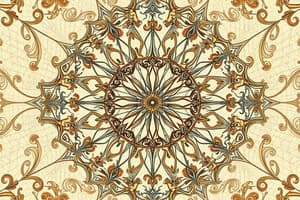Podcast
Questions and Answers
What is the complement of a set A?
What is the complement of a set A?
- A' is the same as set A.
- A' contains elements that are not in A. (correct)
- A' is a subset of A.
- A' contains all elements in A.
Which statement about complementary events is true?
Which statement about complementary events is true?
- Complementary events can have some elements in common.
- Complementary events are always equal.
- The union of A and A' always equals the sample space S. (correct)
- The probability of an event and its complement is always 0.
What does it mean when two events are mutually exclusive?
What does it mean when two events are mutually exclusive?
- They share some common outcomes.
- They can occur at the same time.
- The occurrence of one event implies the other cannot occur. (correct)
- Their probabilities sum to more than 1.
What is the sum of the probabilities of an event A and its complement A'?
What is the sum of the probabilities of an event A and its complement A'?
In a Venn diagram representing event A and its complement A', what does the shaded region represent?
In a Venn diagram representing event A and its complement A', what does the shaded region represent?
If event A has a probability of 0.3, what is the probability of its complement A'?
If event A has a probability of 0.3, what is the probability of its complement A'?
Which statement regarding the relationship between a set and its complement is true?
Which statement regarding the relationship between a set and its complement is true?
If the probability of event A is 0.7, what is the probability of its complement A'?
If the probability of event A is 0.7, what is the probability of its complement A'?
What do A and A' collectively represent in a sample space S?
What do A and A' collectively represent in a sample space S?
Which identity correctly reflects the relationship between the events A and A'?
Which identity correctly reflects the relationship between the events A and A'?
In terms of sets, how is the complement of set A denoted?
In terms of sets, how is the complement of set A denoted?
When provided with a Venn diagram displaying event A and its complement A', what does the area outside of A illustrate?
When provided with a Venn diagram displaying event A and its complement A', what does the area outside of A illustrate?
What does the identity $A \cap A' = \emptyset$ imply about events A and A'?
What does the identity $A \cap A' = \emptyset$ imply about events A and A'?
If $P(A) = 0.4$, what can be inferred about $P(A')$?
If $P(A) = 0.4$, what can be inferred about $P(A')$?
Which statement about the union of complementary events A and A' is accurate?
Which statement about the union of complementary events A and A' is accurate?
What does the complement of set A also represent in relation to set A?
What does the complement of set A also represent in relation to set A?
In terms of conditional probabilities, which of the following is true about A and A'?
In terms of conditional probabilities, which of the following is true about A and A'?
What does the shaded area in a Venn diagram representing A and A' illustrate?
What does the shaded area in a Venn diagram representing A and A' illustrate?
What is the implication of the identity $A imes A' = ext{some set}$?
What is the implication of the identity $A imes A' = ext{some set}$?
Which scenario best illustrates the sum of the probabilities of two complementary events?
Which scenario best illustrates the sum of the probabilities of two complementary events?
In the context of complementary events, what does $P(S)$ represent?
In the context of complementary events, what does $P(S)$ represent?
Which statement about the union of the sets A and A' is incorrect?
Which statement about the union of the sets A and A' is incorrect?
What does the expression $P(A')$ signify in relation to event A?
What does the expression $P(A')$ signify in relation to event A?
What are the implications of having complementary events A and A' in a probabilistic experiment?
What are the implications of having complementary events A and A' in a probabilistic experiment?




